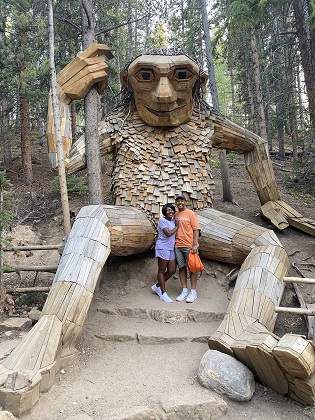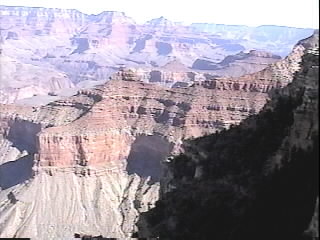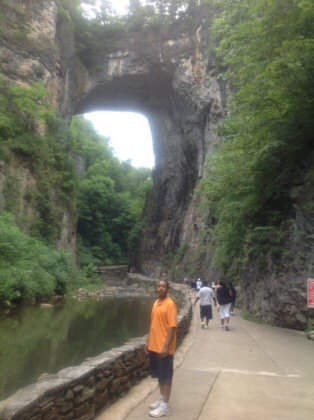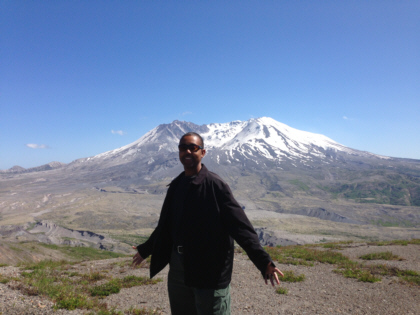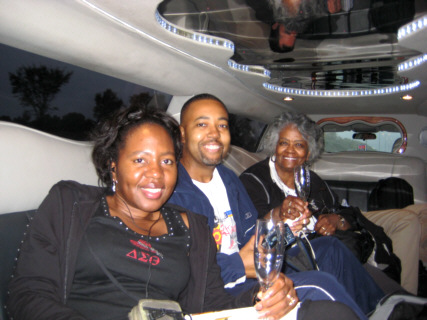Santa Fe (Continued)
The lady started off showing us the highlights of the Girard Wing we were already in. She pointed out interesting angles at which to view the layouts. From there she took us through the Hispanic Heritage Wing. This wing is dedicated to the Spanish that colonized New Mexico several hundred years ago. They were pretty much cut off from Spain so they had to rely on family, faith, and ingenuity to survive. The Hispanic Heritage Wing contains the furniture, utensils, farming equipment, jewelry, and tinwork of these early settlers. They made some very impressive religious relics out of tin.
Our tour guide told us she was going to skip the "Needles and Pins" textile and tools exhibit because it just wasn't her cup of tea. At that point, she ended the tour and Traci and I set off to explore on our own. As soon as we turned the corner, the tour guide came running up to us apologizing because she forgot to take us through the Bamba exhibit. It was the final day of the temporary exhibition. The lady gave Traci and me a personal tour of the gallery.
Sheikh Amadou Bamba (1853-1927) was a highly revered religious leader to the Islamic people of the West African nation of Senegal. He was exiled by the French colonialists who feared he'd organize an uprising against them. But, Bamba believed in non-violence. He gained a huge following. He eventually returned and founded the religious city of Touba, Senegal. The exhibit we saw in the museum was the street art depictions of Bamba. The image of him dressed in a white robe and a white head wrap is painted on everything from murals to buses.
Traci and I learned a lot that day as we explored the Museum Of International Folk Art. We even took a stroll through the "Needles and Pins" wing that our tour guide neglected. It wasn't as bad as she made it sound. There were many examples of weaving looms, quilts, and clothing from all over the world. We ended our visit in the gift shop with Traci perusing the jewelry cases and me skimming books about world cultures. Neither one of us bought anything.
Since the steamed cabbage roll dinner being served at our hotel did not sound very appetizing to us, Traci and I decided to dine out that evening. We consulted The Navi for nearby restaurant suggestions. When Red Lobster showed up on the screen, we unanimously made it our dining spot that evening.
"Say Something! Anything!"
We checked out of the Homewood Suites Wednesday morning and loaded up the car. We would be doing a 270-mile drive to begin the next leg of our vacation in Durango, Colorado. Our itinerary called for a stop in the town of Chimayo, New Mexico along the way.
Chimayo is a small town seemingly in the middle of nowhere. It receives many thousands of visitors each year because of the El Santuario de Chimayo Church. This quaint Spanish-style catholic church is known for its healing power. It turns out this remote church was closer than I thought. We arrived there within 20 minutes of leaving the Homewood Suites.
Traci and I took a look inside the dark, rustic sanctuary but did not linger. The 11 AM mass was going to begin soon. Worshippers had already arrived and were praying the rosary aloud.
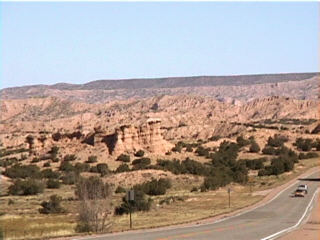
driving to Chimayo
The mystery that has made El Santuario de Chimayo legendary occurred at the site of the small chapel attached to the side of the church. A crucifix was dug up by a friar in the early 1800's after he saw light coming from a hillside. The crucifix was taken 6 miles away to Santa Cruz, NM. However, the cross disappeared and was found again in the same pit in Chimayo. After the third time the cross disappeared from Santa Cruz and reappeared in Chimayo, it was decided to leave it in Chimayo. A small chapel was built on this holy ground. Soon after, people began to tell stories of the miraculous healing they received from visiting the chapel. A larger shrine had to be built in 1816 as more and more people came to the site hoping to be healed.
The original 6-foot crucifix can still be seen on the altar of the main sanctuary, but it is the miraculous healing powers of the dirt pit in the chapel attached to the church that draws visitors.
We entered the tiny chapel and saw the mementos left by the people that have been healed. They've left behind their crutches, canes, photos, and more. At the back of the chapel, there is a room containing the dirt pit that looks to be approximately 2 square feet. There were two small sand shovels in the pit and some disposable cups on the window sill for visitors that wanted to take some of the dirt. Outside the chapel, I saw a few people rubbing the dirt on their bodies.
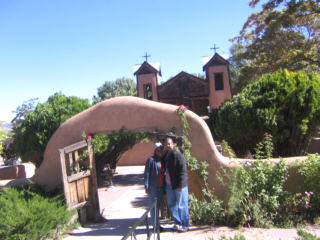
El Santuario de Chimayo Church
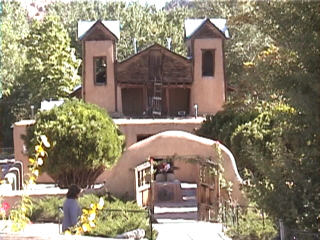
another view
There is a sign in the back of the main church indicating the Catholic Church has not officially recognized any miracles in Chimayo. The dirt comes from the surrounding desert and is blessed by the pastor just as he would bless Holy Water or other items. However, spending a short time here and seeing all the testimonial items people have left behind, it is not a stretch of the imagination to believe that something extraordinary is going on here. Traci and I agreed that of all the places we visited during our vacation, El Santuario de Chimayo felt the most sacred.
Naturally, a tourist attraction would not be a tourist attraction unless there was somewhere for people to spend some money. Chimayo is no exception. There are a handful of souvenir shacks on the premises that sell mainly religious items. The vendors are so friendly and pleasant to talk to. One of the shopkeepers was telling us that during Holy Week, more than 10,000 pilgrims come to Chimayo to pray and see the live Stations of the Cross reenactment. She has met people that have walked from as far as Albuquerque - 90 miles away!
The one question that we were asked by several people while in Chimayo was: Are you doing the High Road To Taos?
Taos, New Mexico was not on our planned itinerary - much less anything called a High Road To Taos. However, one of the shopkeepers described this scenic drive and pointed it out on a map. Taos was actually not very far from our planned route to Durango, Colorado. Since Traci and I had no plans for Durango that day other than to check into the hotel, we decided to make a detour on the High Road To Taos.
We got in the car and pulled out The Navi to see if it knew anything about a High Road To Taos...
Uh oh! Why won't The Navi turn on? We've pressed the 'On' button. Maybe the battery is dead? We should plug the adapter into the cigarette lighter - still nothing.
Traci and I tried everything we could think of for 10 minutes to get The Navi to come on. Despite all our efforts, The Navi remained a blank screen. It would remain inoperable for the rest of our vacation. This was really disappointing.
Anyway, I was once a Boy Scout and I still live by the Boy Scout motto: Be prepared. I had a folder full of Internet directions for all the places we planned to visit on this trip. To cover us for the places we didn't plan to visit, I had the TripTik books and state maps I had ordered from AAA before we left PA. However, there is still nothing like hearing the polite electronic voice of The Navi telling me "In 0.8 miles, turn right."
The directions the shopkeeper gave sounded simple enough - follow Route 76. I handed Traci a map just in case we got off course. Off we drove. It hadn't been more than 20 minutes before Traci and I were arguing over the directions. She eventually gave into my stubbornness and let me drive where I thought we should be going. Before long, I was driving down a gravel road behind some cattlemen and their herd of cattle. I finally admitted to Traci the error in my logic. I pulled up beside one of the cattlemen to ask for directions. This became quite a scene. While I was trying to hear the old man give me directions, the cattle were mooing, the work dog was barking, and a cow was peeing an ocean beside our car. We eventually got back on course.
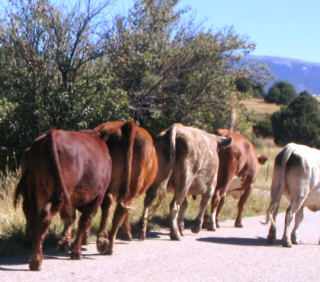
"Uh, I think we're lost."
The High Road To Taos is a 45-mile stretch of roadway between Chimayo and Taos. It takes you through old Spanish settlement towns and past some magnificent canyons. We took our time making frequent stops at scenic overlooks.
Taos, New Mexico is a popular destination for skiers but since it was summertime we didn't know what there was to do when we arrived. I saw a sign pointing to the Taos Visitor Center so we stopped in to get some information. The cheerful lady at the front desk pointed out some things we should see if we're only there for a few hours. When she found out we were heading to Durango, she printed out some direction for us. She was extremely helpful.
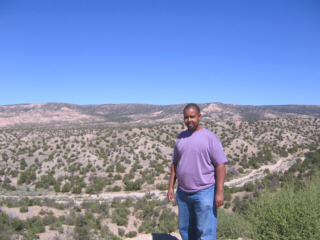
scenic overlook
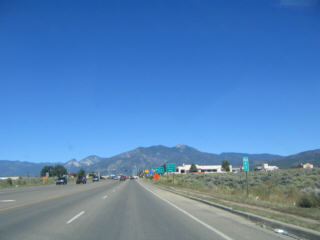
entering Taos
The first attraction we visited was the Taos Pueblo. This is the oldest inhabited pueblo in the U.S.. The Taos Indians have lived in this community for more than 1000 years. There is a $10 per person entrance fee plus an additional $5 for each camera you bring with you. The community consists of dirt roads and adobe homes. The most distinguishing feature of this neighborhood is the large cluster of homes stacked on one another. There are many dogs walking around. The residents don't keep them on leashes or behind fences. Although some of the dogs look intimidating, they generally ignore the tourists.
A college student, who had spent her early years living in here, gave us a tour of the pueblo. She began with the remains of the old St. Jerome Church built by the Spanish in 1619. The Spanish were on a mission to convert the Indians to Catholicism. They told the Indians they would always be safe inside the church. Unfortunately, this was not true. During the U.S.-Mexico war in 1847, the U.S. government destroyed the church and the Indian men, women, and children inside because the Taos Indians were suspected of killing the governor. The church now sits in ruins surrounded by a cemetery of simple wooden crosses. Despite the atrocities they suffered, the Indians still converted to Catholicism but kept some of their religious customs such as burial rituals. The Taos Indians don't bury their dead in caskets. Instead, they wrap the body in a burial cloth and place it in the ground. The burial site is not maintained because of the belief that the earth should reclaim all it has provided. Therefore, we noticed many toppled and/or broken wooden crosses in the cemetery.
There is a newer St. Jerome Church in the community. The interesting thing about it is that an empty casket remains inside to acknowledge the Catholic method of burying the dead.
Our tour guide walked us around the tourist areas of the pueblo while providing all kinds of facts. Much of the community is closed to the public since people live here. Some residents even choose to live in the traditional manner and still rely on the stream that runs through the pueblo as a water source. The tour only lasted twenty minutes. We tipped our guide, as we were reminded to do so several times during her presentation, and then went off to walk around. Many of the residents have converted their homes into souvenir shops where they sell their home-made jewelry, pottery, leather drums, and food. I followed Traci from shop to shop while she searched for her jewelry set.
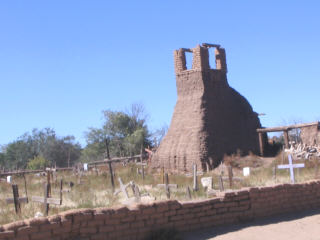
old St. Jerome Church in the cemetery
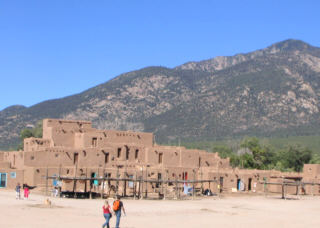
still inhabited after 1000 years
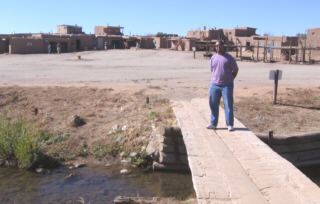
water source for some residents
Leaving Taos Pueblo was a confusing experience. There was a ceremony or something going on that was closed to the public. As a result, we were told to exit down a dirt road. It seemed like we drove on this pot-holed road forever. I kept wondering if we were lost but we eventually ended up on paved roads again.
We spent the rest of our time in Taos at the Taos Plaza. Like the Santa Fe Plaza it is full of shops, restaurants, and hotels. However, the merchandise in Taos seemed mass-produced as opposed to the hand-crafted items in Santa Fe. We were on a lucky streak as far as parking. We passed by the parking lots that charged a fee and pulled right into a spot in the heart of the Plaza. When I got out of the car to put money in the meter, I noticed a sign covering the meters in this area that said something to the effect of Complimentary parking today. Enjoy your visit. During the next 2 hours, Traci visited the jewelry stores and clothing stores while I toured the husband benches. One clothing store actually had a chair labeled 'Husband Seat':). [Continue to Durango...]
Other Road Trips:
